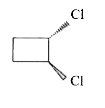Which one of the following compounds show optical activity




The correct Answer is:B
To determine which compound shows optical activity, we will analyze each compound based on the presence or absence of a plane of symmetry (POS). A compound is optically active if it does not have a plane of symmetry, meaning it cannot be superimposed on its mirror image.
1. Identify the Compounds: We have four compounds labeled A, B, C, and D. We need to analyze each one for optical activity.
2. Analyze Compound A:
- Draw a plane of symmetry through the compound.
- Check if the compound can be divided into two identical halves.
- Conclusion: Since a plane of symmetry is present, Compound A is optically inactive.
3. Analyze Compound B:
- Draw a plane of symmetry through the compound.
- Check if the compound can be divided into two identical halves.
- Conclusion: There is no plane of symmetry present, meaning Compound B is optically active.
4. Analyze Compound C:
- Draw a plane of symmetry through the compound.
- Check if the compound can be divided into two identical halves.
- Conclusion: A plane of symmetry is present, so Compound C is optically inactive.
5. Analyze Compound D:
- Draw a plane of symmetry through the compound.
- Check if the compound can be divided into two identical halves.
- Conclusion: A plane of symmetry is present, indicating that Compound D is optically inactive.
6. Final Conclusion: Among the four compounds, only Compound B is optically active as it does not have a plane of symmetry.
Answer:
The compound that shows optical activity is Compound B.
- Draw a plane of symmetry through the compound.
- Check if the compound can be divided into two identical halves.
- Conclusion: Since a plane of symmetry is present, Compound A is optically inactive.
- Draw a plane of symmetry through the compound.
- Check if the compound can be divided into two identical halves.
- Conclusion: There is no plane of symmetry present, meaning Compound B is optically active.
- Draw a plane of symmetry through the compound.
- Check if the compound can be divided into two identical halves.
- Conclusion: A plane of symmetry is present, so Compound C is optically inactive.
- Draw a plane of symmetry through the compound.
- Check if the compound can be divided into two identical halves.
- Conclusion: A plane of symmetry is present, indicating that Compound D is optically inactive.
The compound that shows optical activity is Compound B.
Similar Questions
Knowledge Check
Which of the following compounds loses optical activity due to pyramidal inversion?
A B
B C
C D
D
Which of the following compounds is optically active?
A B
B C
C D
D
Which of the following compounds is optically active?
A B
B C
C D
D
Which of the following compound show optical isomerism?
View SolutionWhich of the following compound show optical isomerism?
View SolutionWhich of the following compounds is optically active ?
View SolutionWhich of the following compounds is optically inactive?
View SolutionWhich of the following compound is optically inactive ?
View Solution

